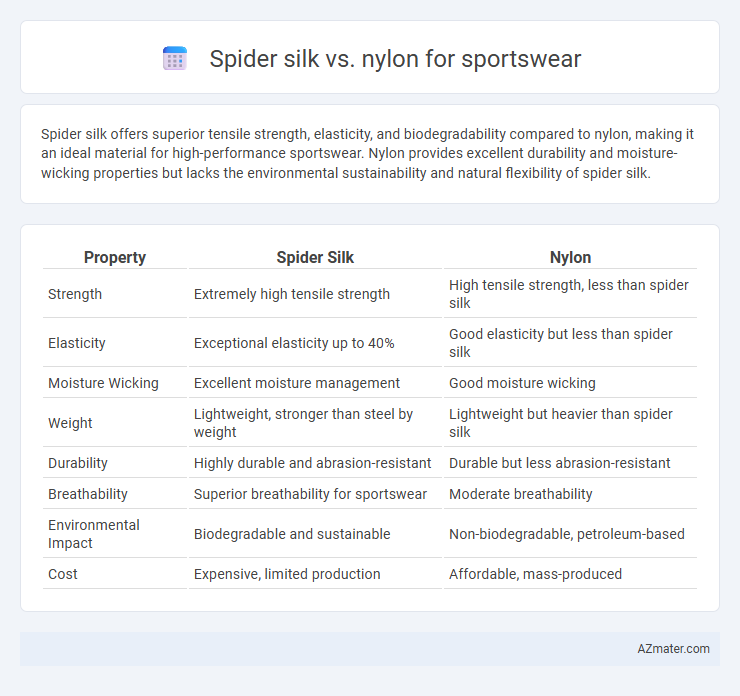Spider silk offers superior tensile strength, elasticity, and biodegradability compared to nylon, making it an ideal material for high-performance sportswear. Nylon provides excellent durability and moisture-wicking properties but lacks the environmental sustainability and natural flexibility of spider silk.
Table of Comparison
| Property | Spider Silk | Nylon |
|---|---|---|
| Strength | Extremely high tensile strength | High tensile strength, less than spider silk |
| Elasticity | Exceptional elasticity up to 40% | Good elasticity but less than spider silk |
| Moisture Wicking | Excellent moisture management | Good moisture wicking |
| Weight | Lightweight, stronger than steel by weight | Lightweight but heavier than spider silk |
| Durability | Highly durable and abrasion-resistant | Durable but less abrasion-resistant |
| Breathability | Superior breathability for sportswear | Moderate breathability |
| Environmental Impact | Biodegradable and sustainable | Non-biodegradable, petroleum-based |
| Cost | Expensive, limited production | Affordable, mass-produced |
Spider Silk vs Nylon: An Introduction to Performance Fibers
Spider silk outperforms nylon in tensile strength, elasticity, and biodegradability, making it an ideal performance fiber for sportswear. Its natural protein structure provides exceptional moisture-wicking and temperature regulation compared to synthetic nylon fibers. Innovations in biomimetic spider silk production aim to replace traditional nylon with sustainable, lightweight, and durable fabrics for enhanced athletic performance.
Mechanical Strength and Durability Comparison
Spider silk exhibits superior tensile strength and elasticity compared to nylon, making it exceptionally resistant to breaking under stress. Its natural protein-based fibers offer unmatched durability with the ability to absorb energy and recover from deformation, which enhances long-term wear performance. Nylon, while strong and abrasion-resistant, lacks the combination of strength and elasticity found in spider silk, often leading to faster material fatigue in high-intensity sportswear applications.
Moisture Management and Breathability
Spider silk outperforms nylon in moisture management due to its hydrophilic protein structure, which efficiently wicks sweat away from the skin, keeping athletes dry and comfortable. Its natural nanostructure enhances breathability by allowing optimal air circulation while maintaining lightweight durability. Nylon, although durable and water-resistant, tends to trap moisture and heat, making it less effective in high-performance sportswear that demands superior ventilation and sweat regulation.
Comfort and Skin Sensitivity Analysis
Spider silk offers superior softness and breathability compared to nylon, making it ideal for sensitive skin and reducing irritation during physical activities. Its natural moisture-wicking properties help maintain dry comfort, while nylon, though durable and elastic, can trap heat and cause chafing under intense exercise conditions. The biocompatible nature of spider silk enhances comfort by minimizing allergic reactions, positioning it as a premium material for high-performance sportswear.
Stretchability and Flexibility in Sportswear
Spider silk exhibits remarkable stretchability and flexibility, with a tensile strength greater than steel and the ability to stretch up to 30%, making it ideal for high-performance sportswear that demands durability and comfort. Nylon, commonly used in sports apparel, offers high elasticity and quick recovery, but its stretch capacity generally peaks around 15-20%, which is less than spider silk. The superior flexibility of spider silk results in enhanced range of motion and reduced material fatigue, positioning it as a promising alternative to traditional nylon in advanced athletic gear.
Weight and Lightweight Textile Advantages
Spider silk outperforms nylon in sportswear due to its exceptional lightweight properties combined with high tensile strength, resulting in durable yet barely-there textiles ideal for performance wear. Its lower density compared to nylon fibers reduces overall garment weight, enhancing athlete mobility and comfort during intense physical activities. This balance of strength and lightness makes spider silk a superior choice for producing advanced, breathable sportswear that supports endurance and agility.
Sustainability and Environmental Impact
Spider silk outperforms nylon in sustainability due to its biodegradability and low environmental footprint during production, requiring minimal water and energy resources. Nylon, derived from petrochemicals, involves high greenhouse gas emissions and persistent microplastic pollution, contributing significantly to environmental degradation. Choosing spider silk sportswear supports eco-friendly practices by reducing reliance on non-renewable resources and minimizing long-term ecological harm.
Cost and Scalability of Production
Spider silk offers superior tensile strength and breathability compared to nylon but remains costly due to complex biofabrication processes and limited large-scale production capabilities. Nylon, a synthetic polymer, benefits from well-established manufacturing infrastructure allowing mass production at relatively low costs, making it the dominant material in sportswear. The high scalability and affordability of nylon currently outweigh spider silk's performance advantages in commercial sportswear applications.
Applications in Modern Athletic Apparel
Spider silk offers exceptional tensile strength, elasticity, and natural moisture-wicking properties, making it ideal for high-performance sportswear that demands durability and comfort. Nylon, widely used in athletic apparel, provides excellent abrasion resistance and quick-drying capabilities but lacks the biodegradability and breathability found in spider silk fibers. Modern athletic brands increasingly explore bioengineered spider silk to create sustainable, lightweight, and high-functionality garments suited for endurance sports and activewear innovation.
Future Prospects: Innovations in Sportswear Fabrics
Spider silk offers unparalleled strength, elasticity, and biodegradability, making it a promising candidate for next-generation sportswear fabrics focused on sustainability and high performance. Nylon remains a widely used material due to its durability and cost-effectiveness, but advances in bioengineered spider silk production aim to surpass nylon's moisture-wicking and temperature-regulating properties. Innovations in blending synthetic fibers with lab-grown spider silk could revolutionize sportswear by enhancing comfort, reducing environmental impact, and improving athletic performance.

Infographic: Spider silk vs Nylon for Sportswear
 azmater.com
azmater.com